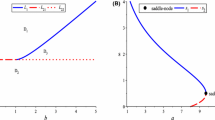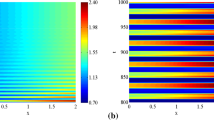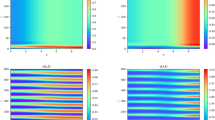Abstract
In this paper, we consider the diffusive Nicholson’s blowflies model in spatially heterogeneous environment when the diffusion rate is large. We show that the ratio of the average of the maximum per capita egg production rate to that of the death rate affects the dynamics of the model. The unique positive steady state is locally asymptotically stable if the ratio is less than a critical value. However, when the ratio is greater than the critical value, large time delay can make the unique positive steady state unstable through a Hopf bifurcation. In particular, the first Hopf bifurcation value tends to that of the “average” DDE model when the diffusion rate tends to infinity. Moreover, we show that the direction of the Hopf bifurcation is forward, and the bifurcating periodic solution from the first Hopf bifurcation value is orbitally asymptotically stable, which improves the earlier result by Wei and Li (Nonlinear Anal 60(7):1351–1367, 2005).



Similar content being viewed by others
References
Busenberg, S., Huang, W.: Stability and Hopf bifurcation for a population delay model with diffusion effects. J. Differ. Equ. 124(1), 80–107 (1996)
Cantrell, R.S., Cosner, C.: Spatial Ecology via Reaction-Diffusion Equations. Wiley Series in Mathematical and Computational Biology. Wiley, Chichester (2003)
Cantrell, R.S., Cosner, C., Hutson, V.: Ecological models, permanence and spatial heterogeneity. Rocky Mt. J. Math. 26(1), 1–35 (1996)
Chen, S., Lou, Y., Wei, J.: Hopf bifurcation in a delayed reaction-diffusion-advection population model. J. Differ. Equ. 264(8), 5333–5359 (2018)
Chen, S., Shen, Z., Wei, J.: Hopf bifurcation in a delayed single population model with patch structure. J. Dyn. Differ. Equ. (to appear) (2021)
Chen, S., Shi, J.: Stability and Hopf bifurcation in a diffusive logistic population model with nonlocal delay effect. J. Differ. Equ. 253(12), 3440–3470 (2012)
Chen, S., Wei, J., Zhang, X.: Bifurcation analysis for a delayed diffusive logistic population model in the advective heterogeneous environment. J. Dyn. Differ. Equ. (2020) (to appear)
Chen, S., Yu, J.: Stability and bifurcations in a nonlocal delayed reaction-diffusion population model. J. Differ. Equ. 260(1), 218–240 (2016)
Faria, T.: Normal forms for semilinear functional differential equations in Banach spaces and applications. II. Discrete Contin. Dyn. Syst. 7(1), 155–176 (2001)
Faria, T., Huang, W.: Stability of periodic solutions arising from Hopf bifurcation for a reaction-diffusion equation with time delay. In: Differential Equations and Dynamical Systems (Lisbon, 2000), Volume 31 of Fields Institute Communications, pp. 125–141. American Mathematical Society, Providence (2002)
Faria, T., Huang, W., Wu, J.: Smoothness of center manifolds for maps and formal adjoints for semilinear FDEs in general Banach spaces. SIAM J. Math. Anal. 34(1), 173–203 (2002)
Feng, Q., Yan, J.: Global attractivity and oscillation in a kind of Nicholson’s blowflies. J. Biomath. 17(1), 21–26 (2002)
Gourley, S.A., Ruan, S.: Dynamics of the diffusive Nicholson’s blowflies equation with distributed delay. Proc. R. Soc. Edinb. Sect. A 130(6), 1275–1291 (2000)
Guo, S.: Stability and bifurcation in a reaction-diffusion model with nonlocal delay effect. J. Differ. Equ. 259(4), 1409–1448 (2015)
Guo, S.: Spatio-temporal patterns in a diffusive model with non-local delay effect. IMA J. Appl. Math. 82(4), 864–908 (2017)
Guo, S., Ma, L.: Stability and bifurcation in a delayed reaction-diffusion equation with Dirichlet boundary condition. J. Nonlinear Sci. 26(2), 545–580 (2016)
Guo, S., Yan, S.: Hopf bifurcation in a diffusive Lotka–Volterra type system with nonlocal delay effect. J. Differ. Equ. 260(1), 781–817 (2016)
Gurney, W., Blythe, S., Nisbet, R.M.: Nicholson’s blowflies revisited. Nature 287(5777), 17–21 (1980)
Győri, I., Trofimchuk, S.I.: On the existence of rapidly oscillatory solutions in the Nicholson blowflies equation. Nonlinear Anal. 48(7, Ser. A: Theory Methods), 1033–1042 (2002)
Hale, J.: Theory of Functional Differential Equations. Applied Mathematical Sciences, vol. 3, 2nd edn. Springer, New York (1977)
Hassard, B.D., Kazarinoff, N.D., Wan, Y.H.: Theory and Applications of Hopf Bifurcation. London Mathematical Society Lecture Note Series, vol. 41. Cambridge University Press, Cambridge (1981)
Hou, X., Duan, L., Huang, Z.: Permanence and periodic solutions for a class of delay Nicholson’s blowflies models. Appl. Math. Model. 37(3), 1537–1544 (2013)
Hu, R., Yuan, Y.: Spatially nonhomogeneous equilibrium in a reaction-diffusion system with distributed delay. J. Differ. Equ. 250(6), 2779–2806 (2011)
Li, W.T., Ruan, S., Wang, Z.C.: On the diffusive Nicholson’s blowflies equation with nonlocal delay. J. Nonlinear Sci. 17(6), 505–525 (2007)
Lin, C.K., Lin, C.T., Lin, Y., Mei, M.: Exponential stability of nonmonotone traveling waves for Nicholson’s blowflies equation. SIAM J. Math. Anal. 46(2), 1053–1084 (2014)
Liu, B.: Global exponential stability of positive periodic solutions for a delayed Nicholson’s blowflies model. J. Math. Anal. Appl. 412(1), 212–221 (2014)
Mei, M., So, J.W.-H., Li, M.Y., Shen, S.S.P.: Asymptotic stability of travelling waves for Nicholson’s blowflies equation with diffusion. Proc. R. Soc. Edinb. Sect. A 134(3), 579–594 (2004)
Shi, Q., Shi, J., Song, Y.: Hopf bifurcation and pattern formation in a delayed diffusive logistic model with spatial heterogeneity. Discrete Contin. Dyn. Syst. Ser. B 24(2), 467–486 (2019)
Shi, Q., Song, Y.: Hopf bifurcation and chaos in a delayed Nicholson’s blowflies equation with nonlinear density-dependent mortality rate. Nonlinear Dyn. 84(2), 1021–1032 (2016)
Shu, H., Wang, L., Wu, J.: Global dynamics of Nicholson’s blowflies equation revisited: onset and termination of nonlinear oscillations. J. Differ. Equ. 255(9), 2565–2586 (2013)
So, J.W.-H., Yang, Y.: Dirichlet problem for the diffusive Nicholson’s blowflies equation. J. Differ. Equ. 150(2), 317–348 (1998)
So, J.W.-H., Yu, J.S.: Global attractivity and uniform persistence in Nicholson’s blowflies. Differ. Equ. Dyn. Syst. 2(1), 11–18 (1994)
So, J.W.-H., Zou, X.: Traveling waves for the diffusive Nicholson’s blowflies equation. Appl. Math. Comput. 122(3), 385–392 (2001)
Su, Y., Wei, J., Shi, J.: Hopf bifurcations in a reaction-diffusion population model with delay effect. J. Differ. Equ. 247(4), 1156–1184 (2009)
Su, Y., Wei, J., Shi, J.: Bifurcation analysis in a delayed diffusive Nicholson’s blowflies equation. Nonlinear Anal. Real World Appl. 11(3), 1692–1703 (2010)
Su, Y., Wei, J., Shi, J.: Hopf bifurcation in a diffusive logistic equation with mixed delayed and instantaneous density dependence. J. Dyn. Differ. Equ. 24(4), 897–925 (2012)
Wei, J., Li, M.Y.: Hopf bifurcation analysis in a delayed Nicholson blowflies equation. Nonlinear Anal. 60(7), 1351–1367 (2005)
Wu, J.: Theory and Applications of Partial Functional-Differential Equations. Applied Mathematical Sciences, vol. 119. Springer, New York (1996)
Yan, X.P., Li, W.T.: Stability of bifurcating periodic solutions in a delayed reaction-diffusion population model. Nonlinearity 23(6), 1413–1431 (2010)
Yang, Y., So, J.W.-H.: Dynamics for the Diffusive Nicholson’s Blowies Equation. Number Added, vol. II, pp. 333–352 (1998). Dynamical Systems and Differential Equations, vol. II. Springfield, MO (1996)
Yi, T., Zou, X.: Global attractivity of the diffusive Nicholson blowflies equation with Neumann boundary condition: a non-monotone case. J. Differ. Equ. 245(11), 3376–3388 (2008)
Zhang, J., Peng, Y.: Travelling waves of the diffusive Nicholson’s blowflies equation with strong generic delay kernel and non-local effect. Nonlinear Anal. 68(5), 1263–1270 (2008)
Author information
Authors and Affiliations
Corresponding author
Additional information
Publisher's Note
Springer Nature remains neutral with regard to jurisdictional claims in published maps and institutional affiliations.
This research is supported by the National Natural Science Foundation of China (No. 11771109) and Shandong Provincial Natural Science Foundation of China (No. ZR2020YQ01).
A Appendix
A Appendix
1.1 The proof of Proposition 3.3
Proof
It follows from Lemmas 2.4, 3.2 and Theorem 2.6 that
Since \(\lim _{r \rightarrow 0 } \psi (x)=\lim _{r \rightarrow 0 } {\overline{\psi }}(x)=c_0\), we see from Eq. (3.8) that
and
Therefore,
This, combined with Eq. (3.24), implies that
In order to analyze the sign of \(\lim _{r \rightarrow 0}{\mathcal {R}}e C_{1}(0)\), we only need to calculate the signs of \(\lim _{r \rightarrow 0}{\mathcal {R}}e (g_{11}e^{-\mathrm{i} \nu _r \tau _n})\), \(\lim _{r \rightarrow 0}({\mathcal {R}}e\frac{{E_r}}{c_0}+\frac{2{F_r}}{c_0}+\frac{c_0}{c_0-2}-c_0)\), \(\lim _{r \rightarrow 0} {\mathcal {I}} m \left( g_{11}e^{-\mathrm{i} \nu _r \tau _n}\right) \) and \(\lim _{r \rightarrow 0}{\mathcal {I}}m\frac{{E_r}}{c_0} \), respectively. From (2.18), we have
then
It follows from (A2) and (A4) that
Then, together with Eq. (A1), yields
and
Note that
Therefore, we obtain

and
From (A1), one also have
Then we see from (A7) and (A9) that
It follows from (A5), (A6), (A8) and (A10) that
For simplicity, we only calculate the numerator of (A11):
Let
Then, when \(c_0>2\), we have
and
Summarizing the (A11), (A12), (A13) and (A14), we have \(\lim _{r \rightarrow 0}{\mathcal {R}}e C_{1}(0)<0\). \(\square \)
Rights and permissions
About this article
Cite this article
Huang, D., Chen, S. The stability and Hopf bifurcation of the diffusive Nicholson’s blowflies model in spatially heterogeneous environment. Z. Angew. Math. Phys. 72, 41 (2021). https://doi.org/10.1007/s00033-021-01473-2
Received:
Revised:
Accepted:
Published:
DOI: https://doi.org/10.1007/s00033-021-01473-2




